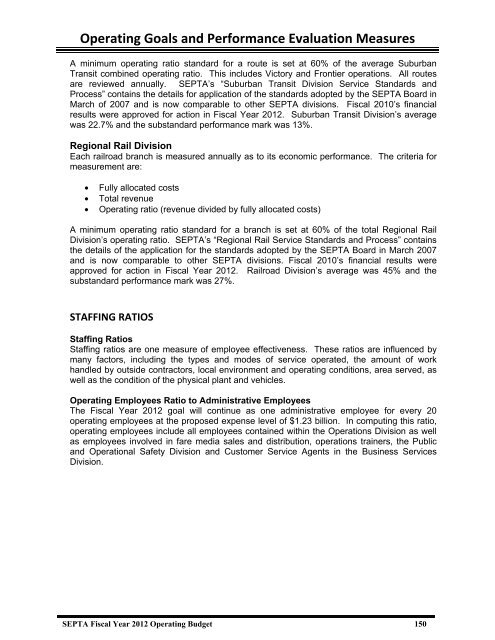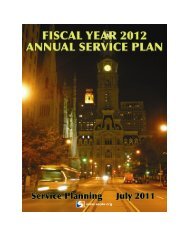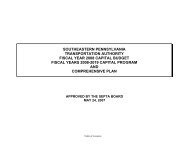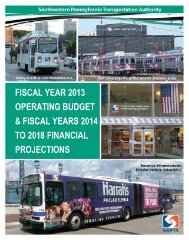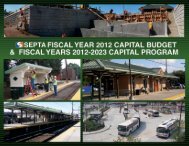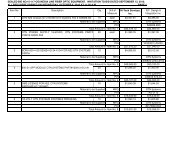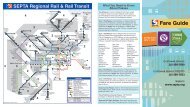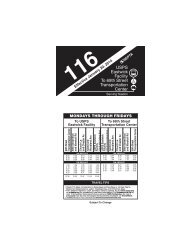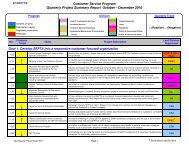FY 2012 Operating Budget and FY 2013-2017 Financial ... - Septa
FY 2012 Operating Budget and FY 2013-2017 Financial ... - Septa
FY 2012 Operating Budget and FY 2013-2017 Financial ... - Septa
Create successful ePaper yourself
Turn your PDF publications into a flip-book with our unique Google optimized e-Paper software.
<strong>Operating</strong> Goals <strong>and</strong> Performance Evaluation Measures<br />
A minimum operating ratio st<strong>and</strong>ard for a route is set at 60% of the average Suburban<br />
Transit combined operating ratio. This includes Victory <strong>and</strong> Frontier operations. All routes<br />
are reviewed annually. SEPTA’s “Suburban Transit Division Service St<strong>and</strong>ards <strong>and</strong><br />
Process” contains the details for application of the st<strong>and</strong>ards adopted by the SEPTA Board in<br />
March of 2007 <strong>and</strong> is now comparable to other SEPTA divisions. Fiscal 2010’s financial<br />
results were approved for action in Fiscal Year <strong>2012</strong>. Suburban Transit Division’s average<br />
was 22.7% <strong>and</strong> the subst<strong>and</strong>ard performance mark was 13%.<br />
Regional Rail Division<br />
Each railroad branch is measured annually as to its economic performance. The criteria for<br />
measurement are:<br />
• Fully allocated costs<br />
• Total revenue<br />
• <strong>Operating</strong> ratio (revenue divided by fully allocated costs)<br />
A minimum operating ratio st<strong>and</strong>ard for a branch is set at 60% of the total Regional Rail<br />
Division’s operating ratio. SEPTA’s “Regional Rail Service St<strong>and</strong>ards <strong>and</strong> Process” contains<br />
the details of the application for the st<strong>and</strong>ards adopted by the SEPTA Board in March 2007<br />
<strong>and</strong> is now comparable to other SEPTA divisions. Fiscal 2010’s financial results were<br />
approved for action in Fiscal Year <strong>2012</strong>. Railroad Division’s average was 45% <strong>and</strong> the<br />
subst<strong>and</strong>ard performance mark was 27%.<br />
STAFFING RATIOS<br />
Staffing Ratios<br />
Staffing ratios are one measure of employee effectiveness. These ratios are influenced by<br />
many factors, including the types <strong>and</strong> modes of service operated, the amount of work<br />
h<strong>and</strong>led by outside contractors, local environment <strong>and</strong> operating conditions, area served, as<br />
well as the condition of the physical plant <strong>and</strong> vehicles.<br />
<strong>Operating</strong> Employees Ratio to Administrative Employees<br />
The Fiscal Year <strong>2012</strong> goal will continue as one administrative employee for every 20<br />
operating employees at the proposed expense level of $1.23 billion. In computing this ratio,<br />
operating employees include all employees contained within the Operations Division as well<br />
as employees involved in fare media sales <strong>and</strong> distribution, operations trainers, the Public<br />
<strong>and</strong> Operational Safety Division <strong>and</strong> Customer Service Agents in the Business Services<br />
Division.<br />
SEPTA Fiscal Year <strong>2012</strong> <strong>Operating</strong> <strong>Budget</strong> 150


